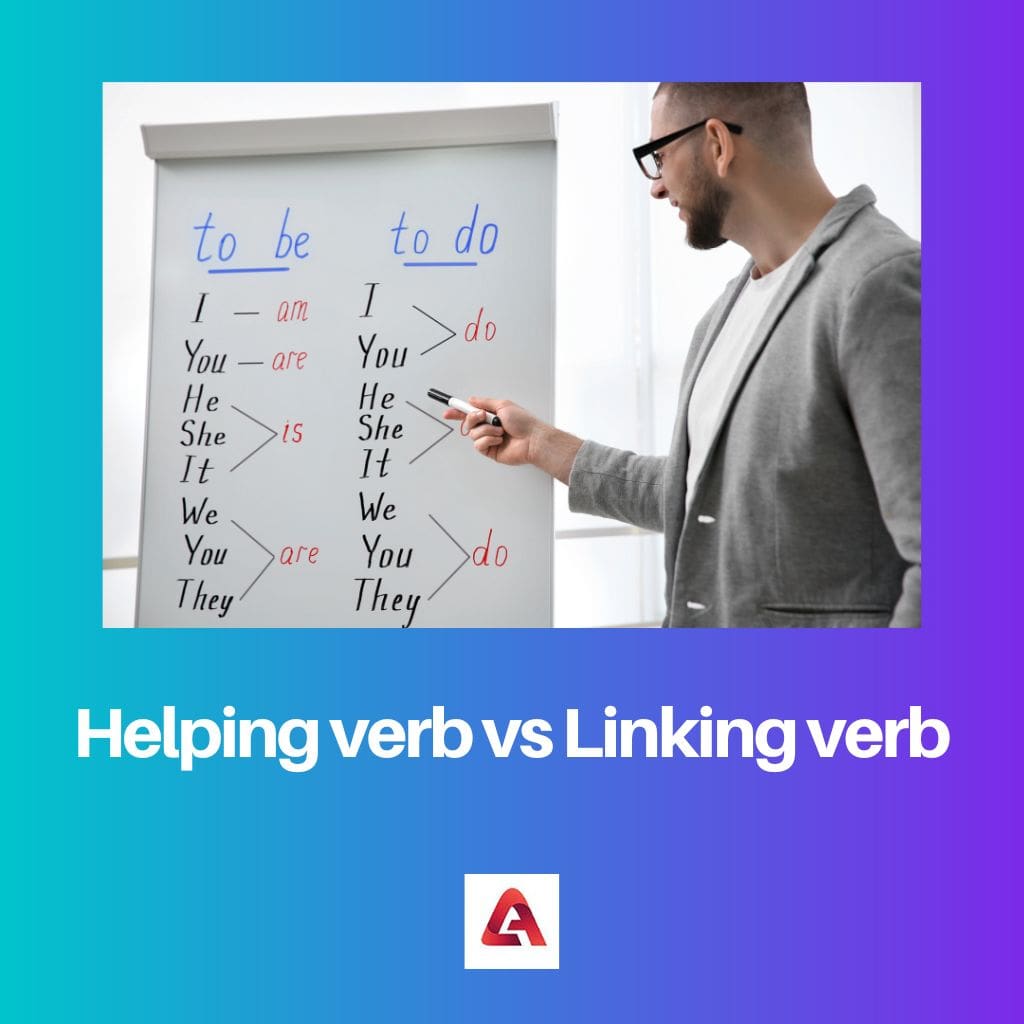A lot of questions come to mind when there are similar terms. Many think both helping and linking verbs are the same and do not differ, as they are used with the subject matter.
Key Takeaways
- Helping verbs, also known as auxiliary verbs, are used in conjunction with main verbs to provide additional information about the action, such as tense, mood, or voice (e.g., “am,” “has,” “will”).
- Linking verbs are used to connect a subject to a subject complement, which describes or identifies the subject, without expressing an action (e.g., “be,” “seem,” “appear”).
- The main difference between helping and linking verbs is their function within a sentence. Helping verbs assist main verbs in conveying additional details and linking verbs connecting subjects to their complements.
Helping Verb vs. Linking Verb
The difference between helping and linking verbs is that the helping verb, also known as the auxiliary verb, helps the main verb—on the other hand, connecting verb-link the subject with further information about the subject.

It is a verb that comes before the main verb. Helping verbs like will, shall, may, can, could, should, would, used, and must are used along with the main verb to convey shades of mood and time.
The linking verb is the verb that creates a connection between the subject and further information about the sentence’s subject. It is a verb that does not show any action but connects the subject’s information.
Comparison Table
| Parameter of Comparison | Helping verb | Linking verb |
|---|---|---|
| Meaning | A helping verb is the type of verb that is used before the main verb in sentences, and it is also known as an auxiliary verb. | A linking verb is used in sentences to connect the subject and further information on the subject. |
| Main verb | Helping verbs cannot be termed as the main verb in the sentences. | It can be the main verb in the sentence. |
| Follow | The principal of the verb follows it. | The subject follows its complements. |
| Work | It gives the extra information in the sentences. | It combines the subject and subject information. |
| Express | It is a verb that expresses an action or state of being. | It is a type of verb that is used in sentences so that it can identify or describe the sentences. |
What is Helping Verb?
A helping verb is also called an auxiliary verb, and it is the type of verb that helps the sentence’s main verb. When used alone, this verb has no meaning, so they are not used as an action verb.
They are called modal verb if it is used in this way. Sentences like: You must eat dinner on time. In this sentence, must is the helping verb where a person shows the requirement to be on time or obligation.
It also chooses the tense in the paragraph, such as the continuous or passive tense. This verb helps to create a sentence that should be progressive and perfect.

What is Linking Verb?
The linking verb connects the main subject of the sentences with the predicate, the subject’s information, or the same sentence to describe or identify or to another word.
A sentence like I am hot. We can see that being is the linking verb in the sentence, used to express being hot in the sentences.
There is also some verb that can be used as an action verb and linking verb in sentences. Sentences like: He feels hot.

Main Differences Between Helping Verb and Linking Verb
- Helping verbS put in the extra information in the sentences. On the other hand, linking verbs combine the subject and subject information.
- Helping is used in sentences to express an action or state of being. On the other hand, a linking verb is used in the sentences so that it can identify or describe the sentences.

- https://pure.mpg.de/pubman/faces/ViewItemOverviewPage.jsp?itemId=item_1456682
- https://onlinelibrary.wiley.com/doi/abs/10.1111/1467-7687.00209

The post gives valid key takeaways about helping and linking verbs.
Yes, I totally agree with you, Fiona!
I’m not sure of the usefulness of this post.
I think we can all agree that the process of understanding this is somewhat tough, I don’t know if it is really important to get to understand this concept.
This is an interesting concept, we all can learn about this and apply it in different situations.
I find this topic challenging and believe it requires more in-depth explanation.
This is quite comprehensive actually, I think it just needs a lot of practice for better understanding.
The comparison table provides a straight forward differentiation between helping verbs and linking verbs.
It could be a little clearer.
Yes, it’s effective in providing a comparison between the two.
I enjoyed reading through the topic.
I don’t think everyone will find this topic interesting, it’s quite specific.
It is quite specific, but still useful to understand.
Not everyone needs to find it interesting, Alice.
It is important to understand these concepts in the study of English language.
Yes, it could really help in learning English.
I think the post lacks in-depth discussion and real-life context, maybe adding practical examples would make it more engaging.
I think practical examples would make it more relatable and engaging.
I think I’ll need to read this a few times to get a better comprehension.
I think the information displayed is very useful and can help further our understanding of the English language.
I believe this is a good explanation of the topic.
I agree, the post highlights a clear difference between the usage of helping and linking verbs. It could be very helpful when learning English.